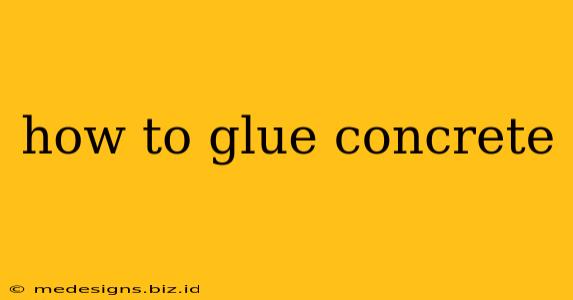Gluing concrete might sound unusual, but it's a surprisingly useful technique for a variety of repair and construction projects. Whether you're patching a crack, bonding two concrete pieces, or attaching other materials to concrete, understanding the right approach is crucial for a strong, lasting bond. This comprehensive guide will walk you through the process, covering everything from choosing the right adhesive to ensuring a successful application.
Understanding the Challenges of Gluing Concrete
Concrete is a porous, relatively inert material. This presents challenges when trying to achieve a strong adhesive bond. Simply slapping on some glue won't do the trick. Successful concrete bonding requires careful preparation and the right type of adhesive. Factors to consider include:
- Surface Preparation: Cleanliness is paramount. Dust, debris, oil, and moisture will all prevent proper adhesion. Thorough cleaning is the most critical step.
- Adhesive Selection: Not all adhesives are created equal. You need a concrete adhesive specifically designed for the task, considering the type of concrete and the intended application.
- Curing Time: Allow sufficient curing time for the adhesive to fully set and develop its maximum bond strength. Ignoring this can lead to failure.
Choosing the Right Concrete Adhesive
The market offers various adhesives suitable for concrete, each with its strengths and weaknesses. Common types include:
- Epoxy Adhesives: Known for their exceptional strength and durability, epoxy adhesives are ideal for high-stress applications and bonding heavy objects to concrete. They offer excellent resistance to water and chemicals.
- Polyurethane Adhesives: These are excellent for filling gaps and cracks, offering superior flexibility and movement accommodation. They're a good choice for applications where the concrete might experience some movement or vibration.
- Acrylic Adhesives: Generally less expensive than epoxy or polyurethane, acrylic adhesives are suitable for less demanding applications, like smaller repairs or attaching lightweight materials. They often require a primer for optimal adhesion.
- Modified Silane Adhesives: These adhesives are specifically formulated to penetrate porous materials such as concrete offering superior bonding. They are very good for filling cracks.
Always carefully read the manufacturer's instructions before selecting and using any adhesive. The instructions will specify the best applications, surface preparation needs, and curing times.
Step-by-Step Guide to Gluing Concrete
-
Preparation is Key: This is the most important step. Thoroughly clean the concrete surfaces to be bonded using a wire brush, scraper, and pressure washer if necessary. Remove all dust, debris, loose material, and any contaminants. Ensure the surfaces are completely dry.
-
Prime the Surfaces (if necessary): Some adhesives require a primer to enhance adhesion, especially on porous concrete. Consult the adhesive manufacturer's instructions. Apply the primer according to the directions and allow it to dry completely.
-
Apply the Adhesive: Follow the manufacturer's instructions for application. Generally, you'll apply a bead of adhesive to one surface and then firmly press the two surfaces together. For larger areas, apply the adhesive evenly.
-
Clamp or Secure (if necessary): For larger pieces or high-stress applications, use clamps or other methods to hold the surfaces together while the adhesive cures. This ensures a strong, even bond.
-
Curing Time: Allow ample curing time. This is crucial for the adhesive to fully set and develop its maximum strength. The curing time will vary depending on the adhesive used; check the manufacturer's instructions.
Troubleshooting Common Problems
- Weak Bond: This usually indicates insufficient surface preparation or the use of an inappropriate adhesive.
- Adhesive Failure: This can be due to moisture contamination, improper application, or insufficient curing time.
- Cracking: This might be caused by stress on the bond or movement of the concrete substrate.
If you encounter problems, carefully review the manufacturer's instructions and consider seeking advice from a concrete professional.
Conclusion
Gluing concrete can be a successful and effective technique with the right approach. By selecting the correct adhesive, preparing the surfaces properly, and following the manufacturer's instructions, you can create a strong and durable bond for various repair and construction projects. Remember, proper preparation and the right adhesive are crucial for success!
